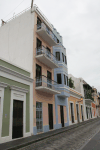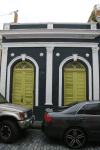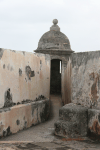
Beach of San Juan. (624k)
Puerto Rico was severly damaged by Hurricane Maria in September 2017. There was still wide spread damage visible when I visited.
All pictures are © Dr. Günther Eichhorn, unless otherwise noted.
San Juan is the capital of Puerto Rico. It has lots of interesting architecture.
The Puerto Rican Athenaeum, Ateneo Puertorriqueño in Spanish, is one of Puerto Rico's chief cultural institutions and was founded in 1876. It serves as a museum, school, library, and performance hall for Puerto Rico.It hosts a number of contests, conferences, and exhibits each year, presenting the best art, literature, and music that Puerto Rico has to offer. Some say that it was the first institution of higher learning in Puerto Rico in which the islands' top minds gave free classes in their areas of expertise. The building dates back to 1923.
The Antiguo Casino de Puerto Rico, located at Avenida Ponce de Leon 1 in San Juan, Puerto Rico, is a Beaux Arts architecture style building dating from 1917. It was listed on the National Register of Historic Places in 1977. It was the brainchild of a group of citizens, known as the Asociación del Casino de Puerto Rico, who requested then San Juan mayor Francisco del Valle Atiles a place to establish a new social club. The building was designed by Montilla & Ferrer and construction began under the supervision of the Del Valle Zeno brothers' firm.
The School of Tropical Medicine (Spanish: Escuela de Medicina Tropical), was an educational institution created in 1926 by an act of the Puerto Rican Legislature, to further the research initiated by the Anemia Commissions and the Institute of Tropical Medicine on anemia and its causes. The institution existed as an independent entity until 1949, when it was integrated into the School of Medicine of the University of Puerto Rico. The building dates back to 1920.
The Capitol of Puerto Rico (Spanish: Capitolio de Puerto Rico) is located on the Islet of San Juan just outside the walls of Old San Juan. The building is home to the bicameral Legislative Assembly, composed of the House of Representatives and Senate. The building is located in the Puerta de Tierra sector of San Juan, it dates back to 1929.
Church, School, Convent and Parish House of San Agustín. It dates back to 1915.









Old San Juan (Spanish: Viejo San Juan) is the oldest settlement within Puerto Rico and the historic colonial section of the city of San Juan. The settlement is a National Historic Landmark District and was listed on the National Register of Historic Places as the "Zona Histórica de San Juan".

















Castillo de San Cristóbal, also known as Fort San Cristóbal, is a fort in San Juan, Puerto Rico. It was built by Spain to protect against land based attacks on the city of San Juan. It is part of San Juan National Historic Site.
Castillo San Cristóbal is the largest fortification built by the Spanish in the New World. When it was finished in 1783, it covered about 27 acres of land and basically wrapped around the city of San Juan. Entry to the city was sealed by San Cristóbal's double gates. After close to one hundred years of relative peace in the area, part of the fortification (about a third) was demolished in 1897 to help ease the flow of traffic in and out of the walled city.
Castillo de San Cristóbal contains five cisterns that were used for the storage of water during the ages of the Spanish Colony. They are extremely large (7 m (23 ft) tall, 5 m (16 ft) wide and 17 m (56 ft) long) and were used as bomb shelters during World War II.
























This page contains 50 pictures
Page last updated on Tue Sep 24 18:19:03 2019 (Mountain Standard Time)
Puerto Rico on gei.geichhorn.com